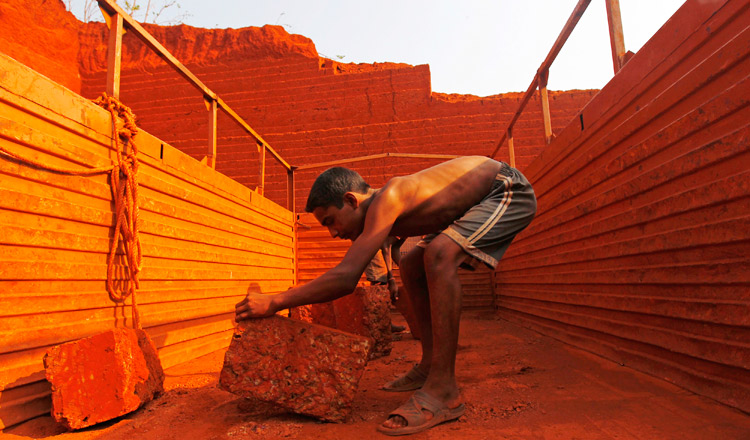JAIPUR (Thomson Reuters Foundation) – In a small windowless room in the heart of Indian tourist magnet Jaipur, Parveena shows a school uniform and tiny shoes to prove that the little boy sitting on the floor, sticking beads on a bangle goes to school and is not a child slave.
Ms Parveena, who would only give her first name, has a workshop located in Jaipur’s Bhatta Basti district, where a maze of buildings along narrow lanes house thousands of units where officials say children have been making bangles for tourists.Born into poverty, thousands of children from the northern Indian state of Bihar have for years been trafficked to tourist-magnet Jaipur to work as slaves making bangles, embroidering or sewing buttons.
To stop this, a major state-backed campaign was launched last month with officials citing the city’s inclusion in India’s $7.5 billion plan to turn 100 urban centers into Smart Cities by 2020 as the motivation.
Although high-speed internet and modern transportation systems are key elements of the Smart City project, in this city of imposing fortresses and palaces, it has caused authorities to take on the problem of child labour. “When it was decided to make Jaipur a smart city, it became important to clean up,” said Narendra Sikhwal, head of Jaipur’s child welfare committee.
“If tourists notice child labour, it creates a wrong impression. Our reputation can’t be harmed. It is a blot on the city,” he told the Thomson Reuters Foundation.Rajasthan state, of which Jaipur is the capital, has about 250,000 child workers, among the most in the country, government data shows.Campaigners warn that the problem could actually be much larger, with data failing to capture the extent of home-based child labour.
The latest Indian census data shows there are nearly 4.4 million child workers in the 5 to 14 age group in India.Officials say 80 percent of the child workers in Jaipur have been trafficked from Bihar to work as slave labour in the handicraft industry that includes hand-embroidered clothes, costume jewelry and bangles.
“Jaipur has a reputation for its crafts and handicrafts and its artisanal industry which is quite at odds with the image of children working at workshops,” said Deepika Allana, programme advisor with Freedom Fund.The Freedom Fund is working in partnership with Jaipur authorities, other non-profits and businesses on the ‘end child labour’ initiative.
Rajasthan’s handicraft industry, including printed textiles, shawls, embroidered fabricsand jewelry, recorded exports worth nearly $2.6 billion in 2017-18.
The rise in demand has led to longer work hours and employers trying to push profit margins by cutting labour costs, campaigners said.
“Handicraft work in Jaipur used to be a family-based local business, but it has expanded in a big way. They want more people to work for more profit,” said Varsha Joshi, head of charity Childline in Jaipur.
Children are preferred by manufacturers as they are easier to control, aren’t paid and have nimble fingers to pick up small beads to stick on bangles or embroider an intricate design on a fabric, officials and campaigners said.
“When we go for rescues, we find children who have been working for over 18 hours for no wages. They are not even able to stand as their knees are bent after sitting for long hours,” Mr Sikhwal said.
Campaigners say past rescue operations failed for lack of government support and the children would be trafficked again within days of their rescue.But the new campaign promises change.Checks at train stations have been intensified and officials from Jaipur have travelled to villages in Bihar to check child trafficking at both source and destination.
Non-profit Goodweave’s ‘child labour free’ certification of carpets will be extended to home textiles, apparel and jewelry sectors of Jaipur and other handicraft hubs of India this year, Deputy Director Archana Mukharji said.
The campaign has made employers in Bhatta Basti alert enough to hide child workers the minute they spot outsiders. But it has not prevented them from using the children.Employers like Parveena cite poverty or an illness in their families as the reason why they take the “help of children” to do the work, even as posters coaxing people to “make Jaipur child-labour free” have appeared near tourist hubs.
At the Child Welfare Committee office, officers speak of the 8-year-old child who ran away the day before from a bangle maker and told them about the “many more children” trapped there.Meanwhile, at the iconic Hawa Mahal – a five-storied pink sandstone palace – shopkeepers sell scarves, bed sheets and bangles to tourists.
“Traders only worry about costs. We buy from whoever gives us the lowest price,” said Arpit Miya Bajaj, who has a shop of Jaipur print rugs near Hawa Mahal.
Article Credit: Khmer times


great information on India’s tourist magnet starts to clean child labour